Without Pity: Ann Rule's Most Dangerous Killers Read online
Page 4
Lie detector tests aren’t foolproof. Some subjects learn to control even their autonomic body responses, keeping their blood pressure and pulse steady. Other subjects cannot perceive right from wrong, and questions evoke neither fear nor remorse. And some subjects are simply insane, impervious to the mysterious machine with its moving stylus.
Jack Stolle seemed psychotic, a man bent on self-destruction. His history was appalling. Born in California, Stolle was one of nine children. His first trouble with the law came when he was fourteen. He was incarcerated and then paroled on four different occasions by youth authorities. Early on he was deeply involved in drugs and had been diagnosed in California as suffering from schizophrenia. His rap sheet eventually listed burglary, forgery, assault, vagrancy, parole violation, grand theft, possession of marijuana, and auto theft.
He married when he was twenty-five and fathered two children, but soon left his responsibilities behind him.
Jack Stolle had been overtly suicidal for most of his adult life. Two years before the double murder of the young women from Oregon, he tried to commit suicide with a razor blade he’d hidden under his tongue while in jail. When taken to a doctor, he attempted to hide a scalpel in his bandages. At other times he had swallowed hypodermic needles and had to be operated on to remove them.
In jail in Chelan County, Stolle slashed his wrists with another razor blade he’d managed to secrete on his person. Sent to Eastern State Hospital to determine if he was fit to stand trial for Patty’s and Beverly’s murders, he had complained of abdominal pain, and admitted that he’d swallowed glass and metal. Five days later, he hung himself with a leather strap, but he was found quickly and jailers were able to get him breathing again.
Two days after that, Stolle broke the toilet in his cell and threatened to slash his wrists with the sharp porcelain edge if anyone came close to him. He had to be coaxed out by jailers. He hadn’t cut his wrists, but he’d severed a tendon in his hand and had to be operated on and wear a cast on his wrist and hand. A day later, he managed to pry the cast off and reopen the incision. As he was rushed back to the hospital, he attempted to jump out of the car.
He was either insane or trying very hard to make authorities believe he was. In the end, the threat of a murder trial was moot. Because he had passed the second lie detector test, the Chelan County Prosecuting Attorney decided not to pursue the murder charges against Stolle. He had enough existing forgery charges hanging over him to send him to prison as it was, and they could always bring murder charges later.
It was a decision that Stolle would not accept. He kept up a lively correspondence with Chelan County detectives, court officials, and even the media. He wanted to confess to the murders of Beverly Johnson and Patty Weidner. He insisted that he was guilty and that he should pay for his crimes.
Detective Jerry Monroe made several trips to the Washington State Penitentiary in Walla Walla to talk to Stolle. He concluded that Stolle had either studied the case so meticulously that he knew as much about it as the investigators did, or he had been there on that night in September 1975. Indeed, he knew details that had never been published in any media coverage about the young women’s deaths.
The problem, however, was that Stolle always veered away when Monroe began to bore in, getting too close for the suspect’s comfort. It may well be that Jack Stolle knew so much about the horrifying scene at the forlorn shelter off Old Downey Road because he had been there and had committed the senseless murders. It may be that he knew the real killer and had gotten the details from him.
After a while, Stolle “cried wolf” too many times. The detectives backed away to give him time to think about it, hoping he would finally tell them the whole truth. Maybe that was what he wanted, after all.
But no one will ever be able to question him now. Jack Stolle died in prison at Walla Walla on October 2, 2001, apparently of natural causes. He was sixty years old.
Mike Harum is the current sheriff of Chelan County, and some twenty-eight years after Beverly Johnson and Patty Weidner were murdered, there may still be a definitive resolution to the mystery of their deaths. In conjunction with several other law enforcement departments, Harum has put together a cold-case squad to study victims who have been lost in the mists of time, who have never had justice done in their cases. With the tremendous advances in forensic science, cold-case investigations now have tools like DNA, AFIS (Automated Fingerprint Identification System), and advanced hair and fiber identification, all of which are successfully helping close decades-old unsolved cases once and for all.
Sometimes, when I am signing books or lecturing, I meet women who knew Bev and Patty on the Oregon coast. They still ask me about their lost friends, but today these women are not in their early twenties. They are in their fifties—just as Bev and Patty would be, had they not made a fatal misjudgment: trusting the wrong man.
*Some names have been changed. The first time they appear, they are marked with an asterisk (*).
Dead and on Tape
Readers often ask me which case I have written about has made the biggest impression on me, and that is virtually impossible to answer. Even so, I think that the stories that stand out most in my mind are the very few where I knew the killer or the victim before the crimes occurred. In thirty years as a crime reporter, I have met literally thousands of police officers and written about hundreds of killers. Sometimes the lines blur. Of course, I will never forget the Ted Bundy case. But there was another homicide case that involved someone I thought I knew well, a case that rocked the Seattle Police Department to its foundations, bringing with it one of the most publicized trials in Washington State history.
When I was a stringer for True Detective Magazine, the detective who was critically injured in the following case was a friend. He was always very cooperative in giving me photographs to accompany my early fact-detective articles. I was in my thirties at the time, divorced less than a year, and during the years that this detective was single, I occasionally had lunch or dinner with him. He was polite and quite handsome, a popular officer in his department, and he worked on many of the cases I wrote about. He was quiet, even a little moody at times. But he was definitely one of the good guys.
Never in a million years would I have expected to listen to him testify, defending himself in a packed courtroom, or that I would be writing about him.
I remember telling him that I would be as fair as I could be, and I believe I was. Indeed, I ran into him one night after the trial was over and he thanked me for showing all sides of this baffling case.
November 20, 1973, was a Tuesday, and it rained all day and all night, standard for Seattle in November. The wind howled and the streets were dark well before supper time. Seattle is so far north that, in November, the sun begins to sink toward the horizon shortly after three.
Most Seattle Police Department Crimes Against Persons detectives worked from 7:45 A.M. to 3:45 P.M., with only a sergeant and four investigators on duty from 3:45 to 11:45 P.M. After midnight, the lights would be turned out on the fifth floor of the Public Safety Building and if an emergency came up, the on-call detectives would respond from their homes. Weekend nights and full moons seemed to spawn the most violent crimes, so a moonless, stormy Tuesday night should have meant a calm interval in the Homicide Unit.
Each quintet of detectives worked the night shift every third month, and Homicide Sergeant Bruce Edmonds’s crew was on during November: George Marberg, Jesse Cook, Al Gerdes, and Bernie Miller. They usually ate dinner at one of the restaurants where cops are a familiar sight; the food was good and the service quick, in case they got a call. Ironically, that night they didn’t expect much to happen.
Edmonds was in his car heading back to the Public Safety Building when he got the worst call any police officer can hear: “Officer down in alley at Boren and Pike. Officer down.”
Edmonds immediately notified his crew and asked them to meet him at the location given. Homicide detectives are only rarely the first to a
rrive at any crime scene. Uniformed officers in patrol cars invariably handle the initial response to a call for help. When the call concerns one of their own, every unit in their sector is on the scene in minutes.
In this case, Patrol Officers Milton McClelland and Richard Duval were working in the 2-George-1 sector of Seattle. In the mid-seventies, “First Hill,” the area around Boren and Pike, was partially commercial, with short blocks occupied by small businesses and shops, running east up the steep hills of Pike and Madison. Along Boren, there were a few banks and a number of large old houses that had long since been chopped up to make low-rent apartments. The patrol partners were used to being summoned to break up fights or quiet drunks who lived in the drab rooms left over from Seattle’s glory days when millionaires outdid themselves building mansions.
“Pill Hill” was nearby, with its plethora of hospitals and clinics.
The area was in transition; by the year 2000, most of the aging mansions were gone and expensive condominiums and hotels had begun to dominate the skyline. But on November 20, 1974, the skyline was hidden in the dark, rainswept night and even the lights of the ferry boats traversing Elliott Bay to the west were fuzzy and muted.
It was a few minutes after 6 P.M. when a woman called the police radio’s emergency number. “One of your detectives has been shot,” she blurted.
“Where did this happen, ma’am?” the operator responded in the calm, even voice he’d been trained to use, even though his heart lurched.
“In an alley—first one south of Pike, off Boren.” And then she hung up.
McClelland and Duval raced to the location, and pulled into a business parking lot between an older hotel and the detox center where they’d often brought alcoholics. They could make out the silhouettes of what appeared to be three people leaning against a low wall. Two of them seemed to be supporting the third. And, as the patrol car’s headlights swept over the parking lot, the officers caught a glimpse of a fourth person, who lay on his back in the pounding rain.
Duval hurried to the fallen body with great apprehension, worried that he was going to recognize a fellow officer. “Is this our man?” he called out to the trio standing nearby.
He looked down at the man and knew that he had to be dead. He had a gaping hole in the middle of his forehead and the puddle beneath him was not water, but blood. To his relief, Duval didn’t recognize him.
“Your guy’s over here,” someone yelled. “He’s hurt bad.”
Duval whirled and this time he did recognize someone. It was Burglary Detective Stan Tappan,* a familiar and popular investigator who worked out of the Burglary Unit in the downtown precinct. Tappan was bleeding profusely from wounds to both his left hand and his abdomen, but he had somehow managed to stay on his feet with the help of passersby.
Patrol Officers Alan Smalley and Leonard Hayes were only thirty seconds behind the first officers, and Stan Tappan lurched over to them, holding his left hand in his right, trying in vain to stop the bleeding.
“Get me to a hospital,” he gasped. “I’ve lost a lot of blood.”
They didn’t stop to ask questions but helped Tappan into the backseat of their patrol car, and sped away, headed for Virginia Mason Hospital, which, fortunately, was only a few blocks away. As Smalley drove, Hayes knelt backward in the passenger seat and applied pressure to Tappan’s injured hand.
“It looked as if his hand had exploded,” he recalled later. “There was a through-and-through wound at close range. His skin was blackened and torn very badly. It seemed to me that his hand was mutilated.”
At the hospital, emergency room personnel helped Stan Tappan remove his clothing and discovered another terrible-looking wound. It too was a through-and-through bullet wound. It looked like a contact wound, with gunpowder burns and debris visible. The skin around this injury was discolored in a five-inch circle of dark purple bruising.
Alan Smalley and Leonard Hayes stayed with Stan Tappan as he waited for X-ray results. They could see he was in great pain, and that his left hand “looked like raw meat.” But he kept his jaw clenched to stop his teeth from chattering. His police training helped him to stay focused and rational, and he was able to answer their questions. They didn’t want to hammer him, but they knew he might have critical internal injuries; they had to try to find out what had happened while he was still conscious.
Stan Tappan told them he’d been working at his second job as a security officer for a mortgage company that evening. There were two parking lots connected to the company. The one directly in front of the entrance was for customers, while employees parked in the side lot off the alley. The mortgage company had considerable cash on hand, and female employees were hesitant to walk to their cars in the dark alley lot during the winter months, so having an armed security guard relieved their anxiety considerably.
Scores of local law enforcement officers worked off-duty jobs at banks, stores, and athletic events. The bank jobs could be dangerous, and indeed a Seattle detective had been fatally shot by a bank robber only a few years earlier.
Stan Tappan said he’d worked in the Burglary Unit that day until his shift was over at 3:45. When he walked out of the police garage, he saw that it was raining fiercely, and he had gone back to his locker to give a friend an extra raincoat he’d stored there. That delayed his leaving the Public Safety Building by ten minutes. He wasn’t due at his second job until 4:30, so he had stopped for a beer at a restaurant that was kitty-corner from headquarters, a spot popular with off-duty cops. Then he had walked several blocks up the Cherry Street hill to where he’d parked his pickup truck, and driven to the mortgage company.
Everything had gone normally, Tappan said, until a man named Nick Kyreacos had shown up in the alley looking for him. Stan Tappan said he knew Kyreacos because he’d been the arresting officer when Kyreacos was charged with credit-card theft. Bizarrely, the man whose card was stolen had been murdered only a few weeks after his arrest. Aware of that, Tappan said he’d been afraid for his own safety when he spotted Kyreacos in the alley.
There had been a struggle, gunfire, and now Kyreacos was dead and Stan Tappan was badly wounded. Good cops hate to have to fire their guns. It’s a familiar saying in law enforcement that “A cop who has to fire his gun is usually wounded more than his target.” When he is forced to kill someone, an officer almost always suffers from prolonged post-traumatic stress disorder.
Back at the scene, Emergency Medical Technician George Barnes walked toward the supine body and leaned over, placing the tips of his fingers against the carotid artery at the side of Kyreacos’s neck. There was no pulse. Despite the near-contact wound in the center of Kyreacos’s forehead, Barnes inserted a plastic airway into his mouth and tried to force air into his lungs with a bellows-like device. There was no response other than the mechanical expansion of his chest.
Not yet ready to give up, Barnes ripped open the man’s jacket, preparing to give him a closed chest massage. But as he did this, he saw a gunshot wound in his chest, too close to his heart and other vital organs for him to have survived. It was far too late for even heroic measures to bring the man back.
John Lombardini and Robert Ryan, investigators for the King County Medical Examiner’s office, were notified that they could pick up the body as soon as the homicide team was through working the crime scene.
Detective Sergeant Bruce Edmonds and his crew had had no difficulty finding the alley where one man lay dead. Blue lights cast their whirling shadows over the drenched black asphalt, and the street was blocked off by patrol cars.
They were shocked to learn that Stan Tappan was the detective who’d been rushed to the hospital. He was not only a fellow officer, Tappan was also a good friend to many homicide detectives. The Burglary Unit was located right next to Homicide and Robbery, and investigators who worked in those units saw each other every day. Stan went elk hunting east of the mountains with several homicide detectives, and usually had a drink after work with them. He was an expert photograph
er and he often took pictures at homicide crime scenes.
Stan Tappan was a cop’s cop who loved his job. He was thirty-two, handsome, 6 feet 1 inch, weighing close to 210 pounds.
Born in New Mexico, Tappan, whose family included five siblings, had moved to Roseburg in southern Oregon when he was a child and he graduated from high school there in 1959. He worked as a logger for a few months and then enlisted in the navy. It was a wise decision for him, and he did extremely well in the service. Tappan mastered two skills that would be especially important in law enforcement, and he’d wanted to be a cop as far back as he could remember.
First, Stan Tappan became a navy diver, trained to swim under cover of darkness on reconnaissance missions. He was fearless in the water, at home as any fish. Like most navy divers, he got a tattoo, one that led into a little deliberately shocking joke he liked to play—a guaranteed conversation stopper.
“Would you believe,” he would say with a sly grin, “that my cock goes down to my ankle?” As faces reddened and people stuttered, Stan would slowly pull up his pant leg to reveal the tattoo of a rooster on his ankle. And then he would explain, “They say that King Neptune protects all creatures who are helpless in the water, and a rooster is about as helpless in the water as anything you can think of.”
Stan Tappan stayed in the service for four years, and was stationed in Florida, Saipan, and Japan. He had a chestful of overseas ribbons, a good conduct medal, and an honorable discharge when he was mustered out just before Christmas, 1963. He went back to logging for a while and then joined the North Bend, Oregon, Fire Department. After working as a firefighter for eighteen months, he still wanted to be a cop. He passed the civil service test for the Springfield, Oregon, Police Department and hired on. He was twenty-four years old, and he knew that this was the profession where he belonged.

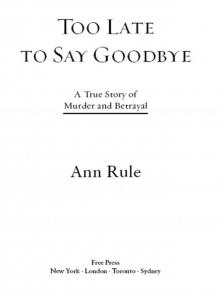 Too Late to Say Goodbye: A True Story of Murder and Betrayal
Too Late to Say Goodbye: A True Story of Murder and Betrayal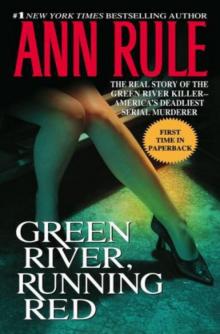 Green River, Running Red
Green River, Running Red Bitter Harvest
Bitter Harvest Dead by Sunset: Perfect Husband, Perfect Killer?
Dead by Sunset: Perfect Husband, Perfect Killer? Lust Killer
Lust Killer And Never Let Her Go: Thomas Capano: The Deadly Seducer
And Never Let Her Go: Thomas Capano: The Deadly Seducer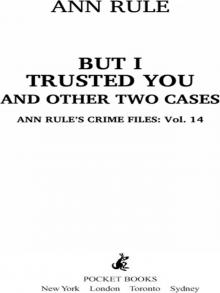 But I Trusted You and Other True Cases
But I Trusted You and Other True Cases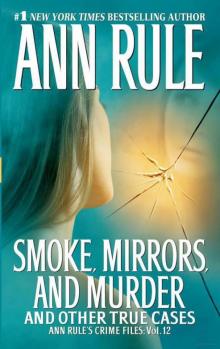 Smoke, Mirrors, and Murder and Other True Cases
Smoke, Mirrors, and Murder and Other True Cases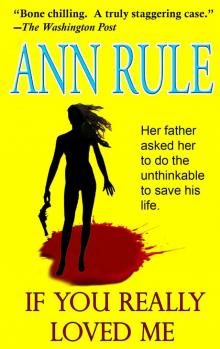 If You Really Loved Me
If You Really Loved Me Kiss Me, Kill Me and Other True Cases
Kiss Me, Kill Me and Other True Cases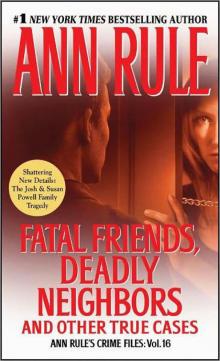 Fatal Friends, Deadly Neighbors and Other True Cases
Fatal Friends, Deadly Neighbors and Other True Cases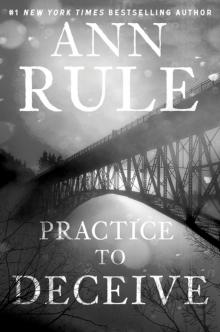 Practice to Deceive
Practice to Deceive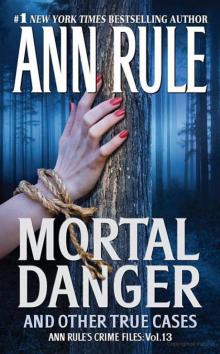 Mortal Danger and Other True Cases
Mortal Danger and Other True Cases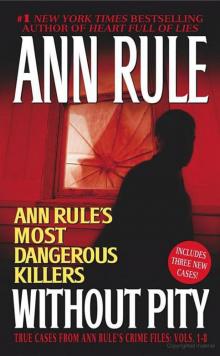 Without Pity: Ann Rule's Most Dangerous Killers
Without Pity: Ann Rule's Most Dangerous Killers Everything She Ever Wanted
Everything She Ever Wanted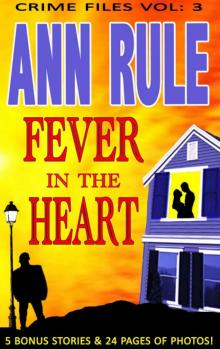 A Fever in the Heart and Other True Cases
A Fever in the Heart and Other True Cases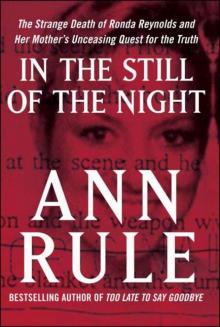 In the Still of the Night
In the Still of the Night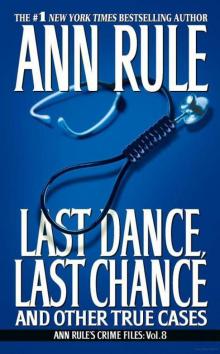 LAST DANCE, LAST CHANCE - and Other True Cases
LAST DANCE, LAST CHANCE - and Other True Cases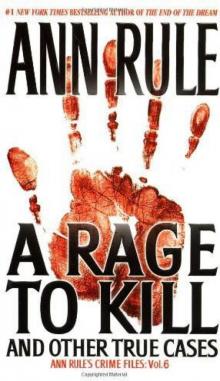 A Rage to Kill
A Rage to Kill The I-5 Killer
The I-5 Killer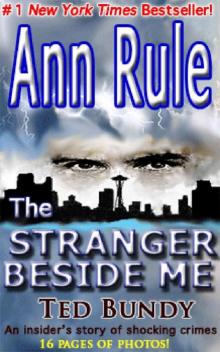 The Stranger Beside Me
The Stranger Beside Me Everything She Ever Wanted: A True Story of Obsessive Love, Murder, and Betrayal
Everything She Ever Wanted: A True Story of Obsessive Love, Murder, and Betrayal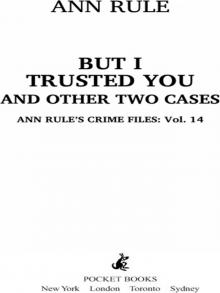 But I Trusted You
But I Trusted You Without Pity
Without Pity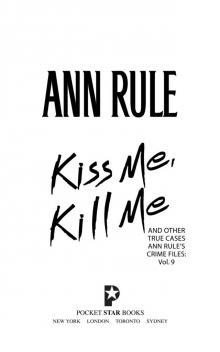 Kiss Me, Kill Me
Kiss Me, Kill Me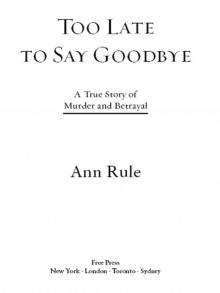 Too Late to Say Goodbye
Too Late to Say Goodbye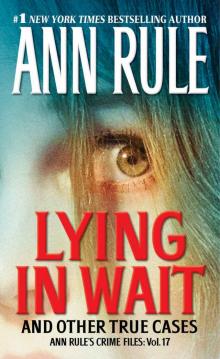 Lying in Wait
Lying in Wait Fatal Friends, Deadly Neighbors
Fatal Friends, Deadly Neighbors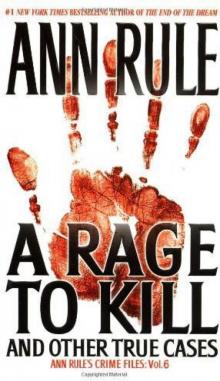 A Rage to Kill: And Other True Cases
A Rage to Kill: And Other True Cases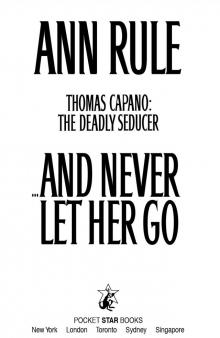 And Never Let Her Go
And Never Let Her Go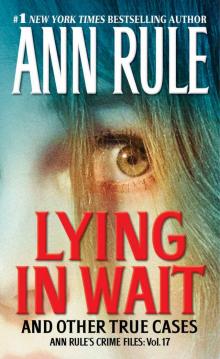 Lying in Wait Ann Rule's Crime Files Vol.17
Lying in Wait Ann Rule's Crime Files Vol.17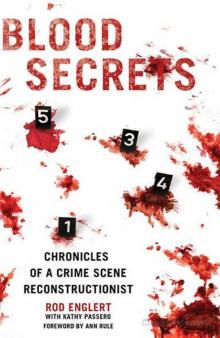 Blood Secrets: Chronicles of a Crime Scene Reconstructionist
Blood Secrets: Chronicles of a Crime Scene Reconstructionist No Regrets
No Regrets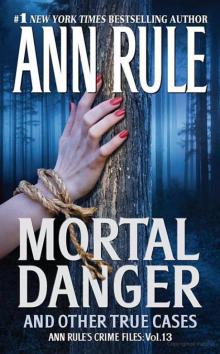 Mortal Danger
Mortal Danger But I Trusted You: Ann Rule's Crime Files #14
But I Trusted You: Ann Rule's Crime Files #14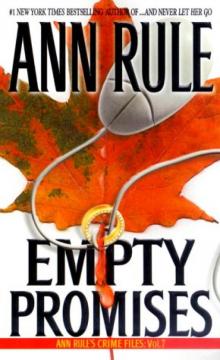 Empty Promises
Empty Promises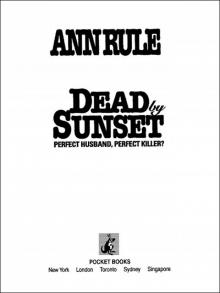 Dead by Sunset
Dead by Sunset Last Dance, Last Chance
Last Dance, Last Chance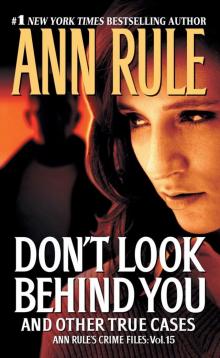 Don't Look Behind You
Don't Look Behind You